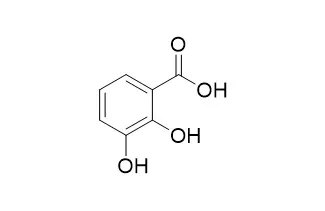| Cell Research: |
| Archives of Biochemistry & Biophysics, 1995, 321(1):263-270. | | NF-kappa B transcription factor activation by hydrogen peroxide can be decreased by 2,3-dihydroxybenzoic acid and its ethyl ester derivative.[Pubmed: 7639530] | Reactive oxygen species like hydrogen peroxide (H2O2) have been shown to serve as messengers in the induction of NF-kappa B and, hence, in the activation and replication of human immunodeficiency virus type 1 (HIV-1) in human cells. Several antioxidant compounds and iron chelators have been shown to interfere with both NF-kappa B and HIV-1 activation under oxidative stress.
METHODS AND RESULTS:
Because 2,3-Dihydroxybenzoic acid (DHB) and its ethyl ester derivative (DHB-EE) are potent oral iron chelators, we started to investigate their effects on monocytes treated with increasing H2O2 concentrations. These two compounds exert important protective effects against the cytotoxic effect of H2O2 as 300 microM DHB or DHB-EE increased cell survival from 30 to 85%. The treatment of monocytes with increasing amounts of H2O2 (from 0 to 3 mM) leads to the nuclear induction of NF-kappa B which is dose dependently inhibited by both DHB and DHB-EE. Addition of ferric ions to DHB only partially restores the NF-kappa B induction by H2O2, while this effect is almost completely restored by ferric ion addition to DHB-EE. Using spin trapping coupled to electron spin resonance, we have demonstrated that DHB and, to a lesser extent, DHB-EE trapped hydroxyl radicals produced by H2O2 photolysis.
CONCLUSIONS:
These data demonstrate that small aromatic molecules harboring both iron-chelating and antioxidant properties like DHB and DHB-EE can effectively interfere with the deleterious effects of H2O2 in monocytes where iron overload can be observed in HIV-1-infected patients. |
|
| Animal Research: |
| Hearing Research, 2006, 212(1-2):99-108. | | 2,3-Dihydroxybenzoic acid attenuates kanamycin-induced volume reduction in mouse utricular type I hair cells.[Pubmed: 16377109] | The aminoglycoside kanamycin is a commonly used antibiotic, but unfortunately it is oto- and nephrotoxic in large doses. The negative effects are thought to be due to the formation of free radicals which is why strong antioxidants and iron chelators like 2,3-Dihydroxybenzoic acid (DHB) are of great interest.
METHODS AND RESULTS:
This study estimates cellular quantitative changes in the utricular macula of mice following systemic treatment with kanamycin alone or in combination with DHB. The animals were injected with either saline, kanamycin or kanamycin + DHB for 15 days and perfusion fixed three weeks after last injection. Total volume of the utricle, as well as total number of hair and supporting cells, were estimated on light microscopic sections. Total volume and mean volume of hair cell types I and II and supporting cells were estimated on digital transmission electron micrographs. Total volume of the utricular macula, hair cell type I and supporting cells decreased significantly in animals injected with kanamycin but not in animals co-treated with DHB. Hair and supporting cell numbers remained unchanged in all three groups.
CONCLUSIONS:
In conclusion, the kanamycin-induced volume reduction of type I hair cells was attenuated by DHB. |
|
| Structure Identification: |
| Journal of Bacteriology, 1994, 176(14):4226. | | Chromosome-mediated 2,3-dihydroxybenzoic acid is a precursor in the biosynthesis of the plasmid-mediated siderophore anguibactin in Vibrio anguillarum.[Pubmed: 8021209] |
METHODS AND RESULTS:
We have isolated a recombinant clone harboring the chromosomal aroC gene, encoding chorismate synthase, from Vibrio anguillarum 775 by complementation of the Escherichia coli aroC mutant AB2849 which was transfected with a cosmid gene bank of the plasmidless V. anguillarum H775-3. The nucleotide sequence was determined, and an open reading frame that corresponds to a protein of 372 amino acids was found. The calculated mass of 40,417 Da was correlated with the size of the V. anguillarum aroC product detected in vitro. The homology of the V. anguillarum aroC gene to the aroC genes of E. coli and Salmonella typhi is 68% at the nucleotide level and 78% at the protein level. The expression of the aroC transcript is not regulated by iron, as determined by Northern (RNA) blot hybridization analysis. After insertion of an antibiotic resistance gene cassette within the cloned aroC gene, an aroC mutant of V. anguillarum was generated by allelic exchange. This mutant is deficient in the production of 2,3-Dihydroxybenzoic acid (2,3-DHBA).
CONCLUSIONS:
Our bioassay and complementation experiments with this mutant demonstrate that the chromosome-mediated 2,3-DHBA is a precursor of the pJM1 plasmid-mediated siderophore anguibactin. |
|






 Cell. 2018 Jan 11;172(1-2):249-261.e12. doi: 10.1016/j.cell.2017.12.019.IF=36.216(2019)
Cell. 2018 Jan 11;172(1-2):249-261.e12. doi: 10.1016/j.cell.2017.12.019.IF=36.216(2019) Cell Metab. 2020 Mar 3;31(3):534-548.e5. doi: 10.1016/j.cmet.2020.01.002.IF=22.415(2019)
Cell Metab. 2020 Mar 3;31(3):534-548.e5. doi: 10.1016/j.cmet.2020.01.002.IF=22.415(2019) Mol Cell. 2017 Nov 16;68(4):673-685.e6. doi: 10.1016/j.molcel.2017.10.022.IF=14.548(2019)
Mol Cell. 2017 Nov 16;68(4):673-685.e6. doi: 10.1016/j.molcel.2017.10.022.IF=14.548(2019)